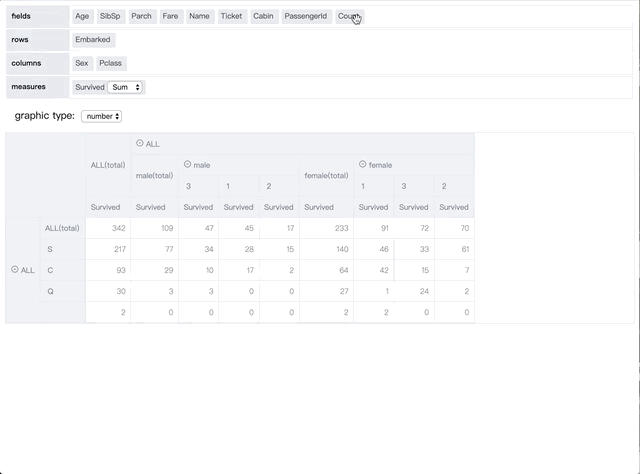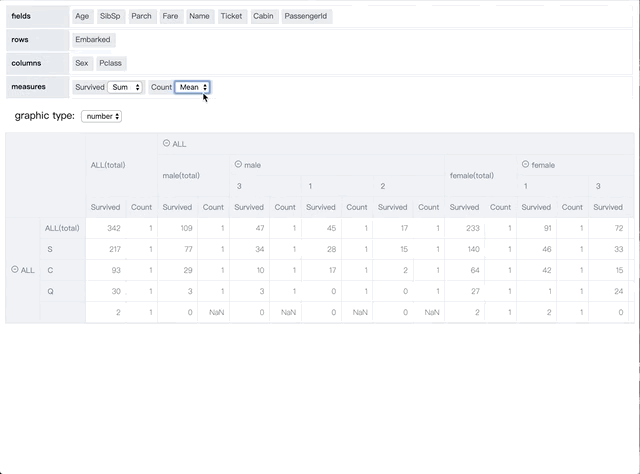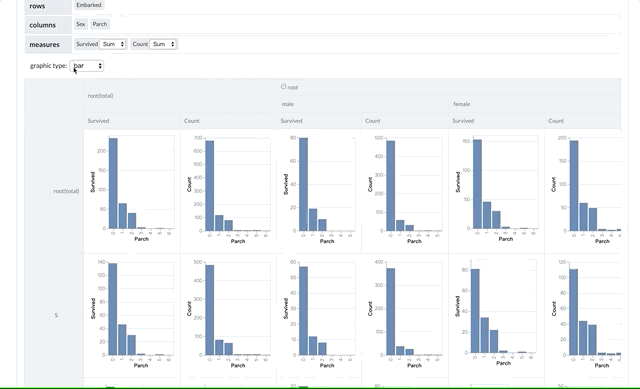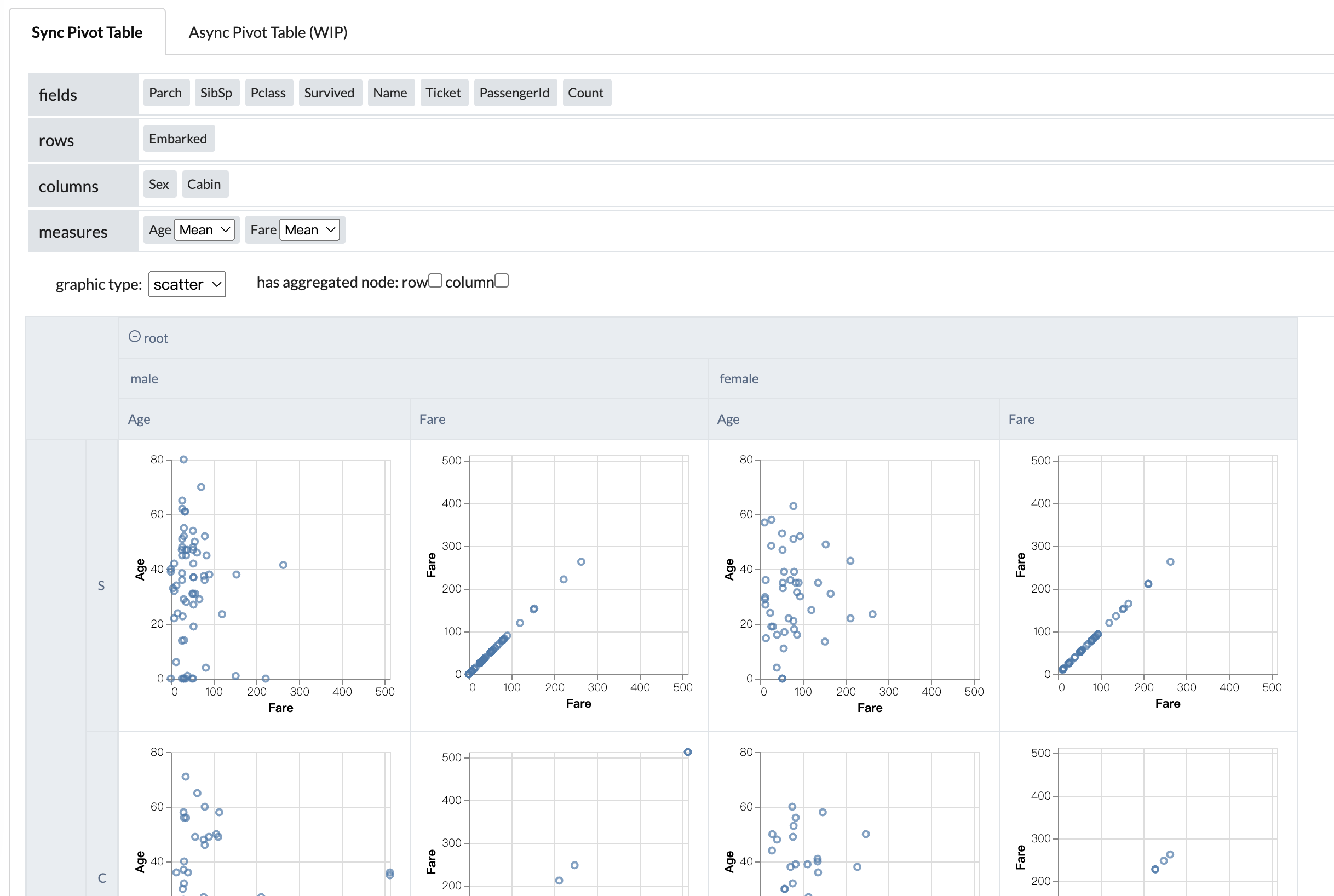English | 简体中文
Pivot-Chart is a comprehensive data visualization tool that enhances pivot tables with visualizations and charts, offering a more intuitive and informative way to analyze your data. With Pivot-Chart, you can elevate your data analysis and take a new approach to exploring your data. Unlike other pivot-table + vis solution, pivot chart retains nest multi-level aggregation feature of pivot table, which allows you to compare between different aggregation levels and make it easier to drill down and roll up.
Integrating Pivot-Chart into your data applications is easy, simply import the npm package.
While this is a proof-of-concept project, your feedback and suggestions are valued and appreciated.
pivot-chart also provide with basic pivot table components for you to build your web apps, you can regard pivot table as a member in the subset of pivot charts.
| feature | demo(gif) |
|---|---|
| basic expandable nest/cross table |  |
| custom aggregator of measures |  |
| different visualization type |    |
install npm package.
npm i --save pivot-chart
# or
yarn add pivot-chart
basic usage.
import { PivotChart } from 'pivot-chart';
function App () {
return <PivotChart
visType={visType}
dataSource={data}
rows={rows}
columns={columns}
measures={measures}
/>
}demo above can be run locally with
# init development environment
yarn workspace react-pivot-table initenv
# start dev server
yarn workspace react-pivot-table dev| Type | Desc |
|---|---|
| Field | - id - name - aggName aggregator's name.- cmp <(a: any, b: any) => number> |
| Measure | extends Field - aggregator aggregator function.- minWidth - formatter <value: number> => number |
| VisType | currently support number , bar , line , scatter . |
| Record | a plain javascript object |
| DataSource | Record[] , Array of Record. |
| QueryNode | - dimCode - dimValue |
| QueryPath | <QueryNode[]>. example: [{dimCode: 'Sex', dimValue: 'male'}, {dimCode: 'Age', dimValue:'*'}] |
common interface are those used in both async pivot table and sync pivot table.
- rows:
Field[]dimensions in row. required - columns:
Field[]dimensions in column.required - measures:
Measure[]measures or indicators.required - visType:
VisTypemark type in cell.numberas default(which is a common pivot table).optional - defaultExpandedDepth. default expanded level in row or column nest tree.optional
- defaultExpandedDepth.rowDepth:
number - defaultExpandedDepth.columnDepth:
number
- defaultExpandedDepth.rowDepth:
- showAggregatedNode:
{row: boolean; column: boolean}whether display aggregated node for each group. optional
- dataSource:
Record[]. Array of record(normaly plain object). (json style data array). required
example:
import React, { useEffect, useState, useMemo } from 'react';
import ReactDOM from 'react-dom';
import { getTitanicData } from './mock';
import { ToolBar, PivotChart, DragableFields, Aggregators, DataSource, VisType, DraggableFieldState } from '../src/index';
const { dataSource, dimensions, measures } = getTitanicData();
const fields = dimensions.concat(measures).map(f => ({ id: f, name: f }));
const initDraggableState: DraggableFieldState = {
fields: [],
rows: [],
columns: [],
measures: []
};
function App () {
const [data, setData] = useState<DataSource>([]);
const [fstate, setFstate] = useState<DraggableFieldState>(initDraggableState)
const [visType, setVisType] = useState<VisType>('number');
useEffect(() => {
setData(dataSource);
}, [])
const measures = useMemo(() => fstate['measures'].map(f => ({
...f,
aggregator: Aggregators[(f.aggName || 'sum') as keyof typeof Aggregators]
})), [fstate['measures']]);
return <div>
<DragableFields onStateChange={(state) => {setFstate(state)}} fields={fields} />
<ToolBar visType={visType} onVisTypeChange={(type) => { setVisType(type) }} />
<PivotChart visType={visType} dataSource={data} rows={fstate['rows']} columns={fstate['columns']} measures={measures} />
</div>
}
ReactDOM.render(<App />, document.getElementById('root'))- cubeQuery:
(path: QueryPath, measures: string[]) => Promise;. A function handle for cube query. path is the groupby dimension path(made of a series of dimension and its value). measures are the fields needed to be aggregated. required - branchFilter: bad api, not recommanded to use it. a fake filter whihc only control display of node and not influence the aggregated result of parent node. optional
- dimensionCompare:
(a: string, b: string) => number.compare function for sort of dimension node. optional
function AsyncApp () {
const [data, setData] = useState<DataSource>([]);
const [fields, setFields] = useState<Field[]>([]);
const [fstate, setFstate] = useState<DraggableFieldState>(initDraggableState)
const [visType, setVisType] = useState<VisType>('number');
useEffect(() => {
const { dataSource, dimensions, measures } = getTitanicData();
setData(dataSource);
const fs: Field[] = [...dimensions, ...measures].map((f: string) => ({ id: f, name: f }));
setFields(fs);
}, [])
const measures = useMemo(() => fstate['measures'].map(f => ({
...f,
aggregator: Aggregators[(f.aggName || 'sum') as keyof typeof Aggregators],
minWidth: 100,
formatter: f.id === 'Survived' && ((val: any) => `${val} *`)
})), [fstate['measures']]);
const cubeQuery = useCallback(async (path: QueryPath, meas: string[]) => {
const ops = measures.filter(m => meas.includes(m.id)).map(m => m.aggName || 'sum');
return TitanicCubeService(path.map(p => p.dimCode), meas, ops);
}, [measures])
return <div>
<DragableFields onStateChange={(state) => {setFstate(state)}} fields={fields} />
<ToolBar visType={visType} onVisTypeChange={(type) => { setVisType(type) }} />
<AsyncPivotChart
visType={visType}
rows={fstate['rows']}
columns={fstate['columns']}
async
defaultExpandedDepth={{
rowDepth: 20,
columnDepth: 20
}}
cubeQuery={cubeQuery}
measures={measures} />
</div>
}- Theme.registerTheme(theme: ThemeConfig)
ThemeConfig
interface ThemeConfig {
root?: {
display?: boolean,
label?: string
},
summary?: {
label?: string
},
table?: {
thead?: {
backgroundColor?: string;
color?: string;
}
borderColor?: string;
color?: string;
}
}
// default config
const THEME_CONFIG: ThemeConfig = {
root: {
display: true,
label: 'All'
},
summary: {
label: '(total)'
},
table: {
thead: {
backgroundColor: '#E9EDF2',
color: '#5A6C84'
},
borderColor: '#DFE3E8',
color: '#333333'
}
};import React, { useEffect, useState, useMemo } from 'react';
import ReactDOM from 'react-dom';
import { getTitanicData } from './mock';
import { ToolBar, PivotChart, DragableFields, Aggregators, DataSource, VisType, DraggableFieldState, Theme } from '../src/index';
const { dataSource, dimensions, measures } = getTitanicData();
const fields = dimensions.concat(measures).map(f => ({ id: f, name: f }));
const initDraggableState: DraggableFieldState = {
fields: [],
rows: [],
columns: [],
measures: []
};
Theme.registerTheme({
root: {
display: true,
label: 'root'
},
summary: {
label: '(total)'
}
})
function App () {
const [data, setData] = useState<DataSource>([]);
const [fstate, setFstate] = useState<DraggableFieldState>(initDraggableState)
const [visType, setVisType] = useState<VisType>('number');
useEffect(() => {
setData(dataSource);
}, [])
const measures = useMemo(() => fstate['measures'].map(f => ({
...f,
aggregator: Aggregators[(f.aggName || 'sum') as keyof typeof Aggregators]
})), [fstate['measures']]);
return <div>
<DragableFields onStateChange={(state) => {setFstate(state)}} fields={fields} />
<ToolBar visType={visType} onVisTypeChange={(type) => { setVisType(type) }} />
<PivotChart visType={visType} dataSource={data} rows={fstate['rows']} columns={fstate['columns']} measures={measures} />
</div>
}
ReactDOM.render(<App />, document.getElementById('root'))SyncPivotChart vs. AsyncPivotChart ?
Sync Pivot Chart does all cube computaion in frontend.(In future, it may do those work in webworker and it will seems to be async).
Async Pivot Chart can use cube query from server or customed implementation(either on server or browser, async or sync), but developer need to figure out how to speed up those by themsleves.




